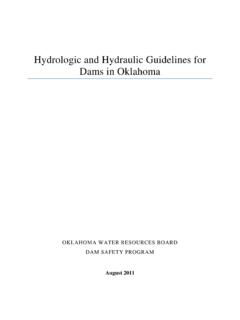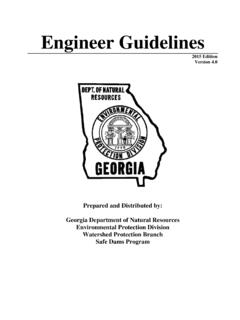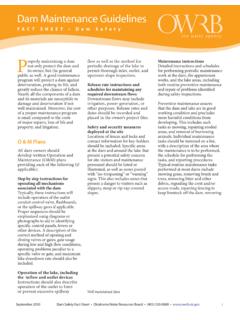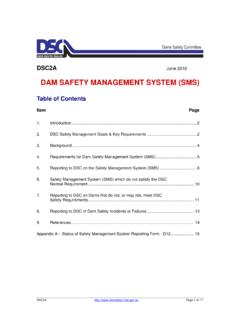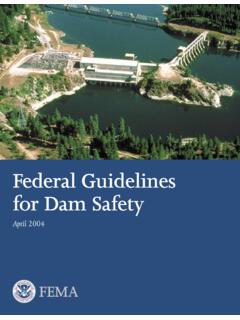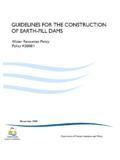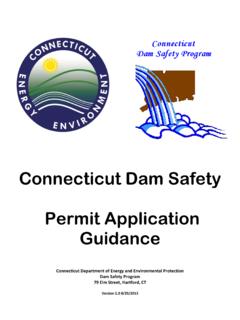Transcription of REGULATORY FRAMEWORK FOR DAM SAFETY - …
1 REGULATORY FRAMEWORK FOR DAM SAFETY - COMPARATIVE ASSESSMENT Mario Scaletta, Vice President-Global Business Development, Paul C. Rizzo Associates, Inc., USA Fehmida Mesania, , , Project Supervisor, Paul C. Rizzo Associates, Inc., USA John P. Osterle, , Vice President Dams & Water Resources Projects, Paul C. Rizzo Associates, Inc., USA Jared Deible, , Managing Principal, Paul C. Rizzo Associates, Inc., USA _____ ABSTRACT According to estimates, in Brazil there are approximately 300,000 dams of vital economic importance in terms of water supply, power generation and support for industry and mining.
2 Brazil s National Water Agency (ANA) has estimated that approximately 200 dams could be in danger of failing. Prior to 2010, Brazil did not have any laws or regulations that address dam SAFETY in either the federal or state level. In 1999, the S o Paulo branch of the Brazilian Committee on Dams published a Basic Guide on Dam SAFETY based on the Canadian Dam SAFETY Guidelines. Such guidelines have become a general reference for dam owners and HPP operators in Brazil. Due to a lack of reliable information, a centralized REGULATORY agency, and a deficiency in the auditing process, resulted in an alarming number of accidents involving dams have occurred in Brazil with serious impact to the environment and surrounding communities.
3 Recently, there have been some movements that resulted in a Brazilian dam SAFETY statute Pol tica Nacional de Seguran a de Barragens (PNSB) published in September of 2010. This law establishes the National Policy on SAFETY of Dams and creates the National System of Information on SAFETY of Dams in Brazil. This paper compares the Brazilian REGULATORY frameworks applicable to dam SAFETY with laws and regulations from the United States and Canada. The paper attempts to highlight the main similarities and differences in the approaches adopted by other countries.
4 Presented at Hydrovision Brazil, Rio de Janeiro, September 25-27, 2012 Paul C. Rizzo Associates, Introduction: According to estimates, in Brazil there are approximately 300,000 dams of vital economic importance, in terms of water supply, power generation, and support for industry and mining. Brazil s National Water Agency (ANA) has estimated that approximately 200 dams could be in danger of failing. Prior to 2010, Brazil did not have any laws or regulations that address dam SAFETY in either the federal or state level.
5 In 1999, the S o Paulo branch of the Brazilian Committee on Dams published a Basic Guide on Dam SAFETY based on the Canadian Dam SAFETY Guidelines. Such guidelines have become a general reference for dam owners and HPP operators in Brazil. Due to a lack of reliable information, a centralized REGULATORY agency, and a deficiency in the auditing process, an alarming number of accidents involving dams have occurred in Brazil with serious impact to the environment and surrounding communities. Recently, there have been some movements that resulted in a Brazilian dam SAFETY statute Pol tica Nacional de Seguran a de Barragens (PNSB) published in September of 2010.
6 This law establishes the National Policy on SAFETY of Dams and creates the National System of Information on SAFETY of Dams in Brazil. This study shows a comparative assessment of the Brazilian REGULATORY frameworks applicable to dam SAFETY as shown in Table 1. The comparison attempts to highlight the main similarities and differences in the approaches adopted by other countries ( United States, Canada) including a review of the Energy REGULATORY Agency (ANEEL) and the new National Water Agency (ANA). Table 1: Listing of Dam SAFETY Legislation or Regulations Country Dam SAFETY Legislation Brazil Pol tica Nacional de Seguran a de Barragens (PNSB), Law (2010) Canada Dam SAFETY Guidelines with Regulations for each Province/Territory USA Privatley owned Hydropower Dams Federal Energy REGULATORY Commission Engineering (FERC)
7 Guidelines Army Corps of Engineers self regulated under their own Dam SAFETY Program Bureau of Reclamation - self regulated under their own Dam SAFETY Program Privately Owned Dams 49 of 50 states have their own dam SAFETY REGULATORY program. Source: International WaterPower & Dam Construction, 2012 Presented at Hydrovision Brazil, Rio de Janeiro, September 25-27, 2012 Paul C. Rizzo Associates, REGULATORY FRAMEWORK in Brazil: The Pol tica Nacional de Seguran a de Barragens (PNSB) Law No. published 20 September of 2010, establishes the National Policy on SAFETY of Dams and creates the National System of Information on SAFETY of Dams in Brazil.
8 The PNSB revises the article 35 of Law No. dated 8 January, 1997 and article 40 of Law No. dated 17 July, 2000 (Presid ncia da Rep blica, 2010). It is composed of six chapters divided into 23 articles (Presid ncia da Rep blica, 2010). This law provides for the regulation and SAFETY of dams and reservoirs throughout Brazil in order to protect the health, SAFETY and welfare of its citizens and their property. The six chapters describe the objectives, definitions, inspection, instrumentation, and REGULATORY agency role.
9 According to the Brazilian law, the system will promote coordination between responsible entity ( owners or operators and the inspectors of the dams and aid in the preparation of the dam SAFETY report. The prime responsibility for dam SAFETY rests with the entity responsible for the dam. However, the dam SAFETY oversight is the responsibility of the entity which granted the right of use of water resources, except for hydroelectric power dams. The supervisory agency must consolidate the registry, whose supervision lies under its responsibility, in a period of two years (Presid ncia da Rep blica, 2010).)
10 Entities responsible for the dam are then requested to submit for approval a report specifying the actions and timeline for implementing a SAFETY plan. This law is applied to dams holding water for any use including water supply, power generation, and mine tailings (Presid ncia da Rep blica, 2010). It also establishes definitions for dams, reservoirs, dam SAFETY , responsible entity, REGULATORY agency, risk management, and potential dam damage. Law regulates all dams that meet or exceed any one of the following criteria: 1. The height of the dam ( from the lowest foundation point to the crest of the dam) larger or equal to 15 m; 2.


